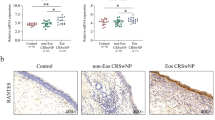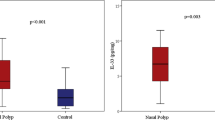Abstract
Eosinophilic granulocytes (Eos) are found in great numbers both in the tissue and in the mucus of patients suffering from chronic rhinosinusitis with polyposis (ECRS). Interleukin-16 (IL-16) is known as a highly potent chemotactic and chemoattractant molecule (ED 10−11) for Eos. In an open, explorative, controlled study we examined the presence of IL-16 in mucosa tissue, mucus and serum in patients suffering from ECRS and its association to Eos activation. Tissue and nasal mucus specimen from 10 previously untreated, non allergic ECRS-patients undergoing paranasal sinus surgery and from 10 healthy non sinusitis subjects, undergoing nasal surgery because of anatomic nasal obstruction were investigated by real-time (RT-) PCR targeting human IL-16 mRNA. Haematoxylin-eosin (HE) staining and immunohistochemistry of formalin embedded tissue and mucus were applied for detection and determination of the proportion of activated Eos (aEos) and IL-16. Serum IL-16 was analyzed by enzyme-linked-immunosorbent assay (ELISA). IL-16 mRNA and IL-16 protein levels were elevated in nasal mucus, polyp tissue and in the serum of ECRS patients compared to healthy controls. There was a high proportion of aEos in ECRS patients compared to healthy subjects. Serum IL-16, IL-16 mRNA expression and IL-16 protein in mucus and tissue specimens were significantly associated with the presence of aEos in polyps of ECRS patients. Immunohistochemically IL-16 protein was mainly expressed in aEos, mast cells, lymphocytes and epithelial cells. In conclusion our data indicate that IL-16 may stimulate the migration and persistence of activated Eos in ECRS. IL-16 production in ECRS patients is not mediated by Immunglobuline-E (IgE).



Similar content being viewed by others
References
Bachert C, Gevaert P, Holtappels G, Cuvelier C, Van Cauwenberge P (2000) Nasal polyposis: from cytokines to growth. Am J Rhinol 14:279–290
Bandeira-Melo C, Sugiyama K, Woods LJ, et al (2002) IL-16 Promotes leukotriene C4 and IL-4 release from human eosinophils via CD4- and autocrine CCR3-chemokine-mediated signaling. J Immunol 168:4756–4763
Benninger MS, Ferguson BJ, Hadley JA, et al (2003) Adult chronic rhinosinusitis: definitions, diagnosis, epidemiology and pathophysiology. Otolaryngol Head Neck Surg 129S:1–32
Blaschke V, Reich K, Blaschke S, Zipprich S, Neumann C (2000) Rapid quantitation of proinflammatory and chemoattractant cytokine expression in small tissue samples and monocyte-derived dendritic cells: validation of a new real-time RT-PCR technology. J Immunol Methods 246:79–90
Cheng G, Ueda T, Eda F, Arima M, Yoshida N, Fukuda T (2001) A549 Cells can express interleukin-16 and stimulate eosinophil chemotaxis. Am J Respir Cell Mol Biol 25:212–218
Cruikshank WW, Kornfeld H, Center DM (2000) Interleukin-16. J Leukoc Biol 67:757–766
Ferland C, Flamand N, Davoine F, Chakir J, Laviolette M (2004) IL-16 activates plasminogen-plasmin system and promotes human eosinophil migration into extracellular matrix via CCR3-chemokine-mediated signalling and by modulating CD4 eosinophil expression. J Immunol 173:4417–4424
Hamilos DL, Leung DYM, Wood R, et al (1995) Evidence for distinct cytokine expression in allergic versus non aöllergic chronic sinusitis. J Allergy Clin Immunol 96:537–544
Karaki M, Dobashi H, Kobayashi R, Tokuda M, Ishida T, Mori N (2005) Expression of interleukin-16 in allergic rhinitis. Int Arch Allergy Immunol 238:67–72
Katzenstein AL, Sale SR, Greenberger PA (1983) Allergic Aspergillus sinusitis: a newly recognized form of sinusitis. J Allergy Clin Immunol 72:89–93
Kountakis SE, Arango P, Bradley D, Wade ZK, Borish L (2004) Molecular and cellular staging for the severity of chronic rhinosinusitis. Laryngoscope 114:1895–1905
Laberge S, Durham SR, Ghaffer O, et al (1997) Expression of IL-16 in allergen-induced late-phase nasal responses and relation to topical glucocorticosteroid treatment. J Allergy Clin Immunol 100:569–574
Laberge S, Pinsonneault S, Varga EM, et al (2000) Increased expression of IL-16 immunoreactivity in bronchial mucosa after segmental allergen challenge in patients with asthma. J Allergy Clin Immunol 106:293–301
Lee CH, Lee KS, Rhee CO, Lee SO, Min YG (1999) Distribution of RANTES and IL-5 in allergic nasal mucosa and nasal polyps. Ann Otol Rhinol Laryngol 108:594–598
Meltzer EO, Hamilos DL, Hadley JA, et al (2004) Rhinosinusitis: establishing definitions for clinical research and patient care. J Allergy Clin Immunol Suppl 114(6):155–211
Pullerits T, Lindén A, Malmhäll C, Lötvall J (2001) Effect of seasonal allergen exposure on mucosal IL-16 and CD4+ cells in patients with allergic rhinitis. Allergy 56:871–877
Stordeur P, Poulin LF, Craciun L, Zhou L, Schandené L, Lavareille de A, Goriely S, Goldman M (2002) Cytokine mRNA quantification by real-time PCR. J Immunol Methods 259:55–64
Steiner E, Kleinhappl B, Gutschi A, Marth E (1998) Analysis of hsp 70 mRNA levels in HepG2 cells exposed to various metals differing in toxicity. Toxicol Lett 97:169–176
Taha RA, Laverge S, Hamid Q, Olivenstein R (2001) Increased expression of the chemo attractant cytokinese, monocyte chemotactic protein-4, and interleukin-16 in induced sputum in asthmatic patients. Chest 120:595–601
Takeno S, Hirakawa K, Ueda T, Furukida K, Osada R, Yajin K (2002) Nuclear faktor-kappa B activation in the nasal polyp epithelium: relationship to local cytokine gene expression. Laryngoscope 112:53–58
Yang M, Hogan SP, Mahalingam S, et al (2003) Eotaxin-2 and IL-5 cooperate in the lung to regulate IL-13 production and airway eosinophilia and hyperreactivity. J Allergy Clin Immunol 112:935–943
Acknowledgments
EG2 Ab kindly provided by Karin Walcher from Pharmacia (Pfizer Austria).
Author information
Authors and Affiliations
Corresponding author
Additional information
Andreas Lackner and Reinhard Raggam contributed equally to this article.
Rights and permissions
About this article
Cite this article
Lackner, A., Raggam, R.B., Stammberger, H. et al. The role of interleukin-16 in eosinophilic chronic rhinosinusitis. Eur Arch Otorhinolaryngol 264, 887–893 (2007). https://doi.org/10.1007/s00405-007-0300-6
Received:
Accepted:
Published:
Issue Date:
DOI: https://doi.org/10.1007/s00405-007-0300-6




